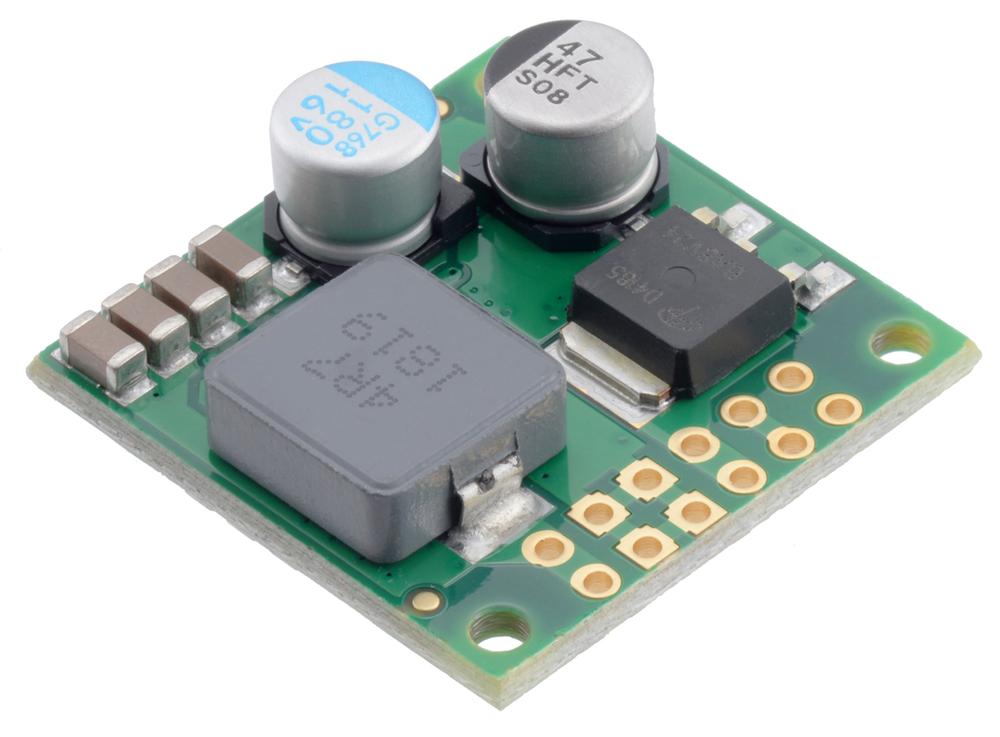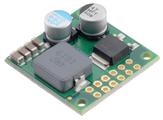We're open! Orders will be shipped today until around 2:00 PM. Merry Christmas Eve!
Pololu 12V, 4.5A Step-Down Voltage Regulator D36V50F12

Description Attachments
This powerful synchronous switching step-down (or buck) regulator takes an input voltage of up to 50 V and efficiently reduces it to 12 V. The board measures only 1″ × 1″ yet delivers typical maximum continuous output currents between 2.3 A and 6.5 A, depending on the input voltage, which makes it well suited for powering moderate to large loads. An optional enable input with a precise cutoff threshold can be used to put the regulator in a low-power state with a current draw of 10 µA to 20 µA per volt on VIN. The regulator also features reverse voltage protection and a power-good output that indicates when the regulator cannot adequately maintain the output voltage.
The D36V50Fx family of buck (step-down) voltage regulators generates lower output voltages from input voltages as high as 50 V. They are switching regulators (also called switched-mode power supplies (SMPS) or DC-to-DC converters), which makes them much more efficient than linear voltage regulators, especially when the difference between the input and output voltage is large. These regulators can typically support continuous output currents between 2 A and 9 A, depending on the input voltage and output voltage (see the Maximum continuous output current section below). In general, the available output current is a little higher for the lower-voltage versions than it is for the higher-voltage versions, and it decreases as the input voltage increases.
The D36V50Fx family of buck (step-down) voltage regulators generates lower output voltages from input voltages as high as 50 V. They are switching regulators (also called switched-mode power supplies (SMPS) or DC-to-DC converters), which makes them much more efficient than linear voltage regulators, especially when the difference between the input and output voltage is large. These regulators can typically support continuous output currents between 2 A and 9 A, depending on the input voltage and output voltage (see the Maximum continuous output current section below). In general, the available output current is a little higher for the lower-voltage versions than it is for the higher-voltage versions, and it decreases as the input voltage increases.
Properties
Brand information
| Brand | Pololu |
| Model | 4095 |
Functionality
| Type of conversion | step down |
Connection data
| Voltage | 13,3 V - 50 V |
| Output voltage | 12 V |
Datasheet
| Current | 4,5 A |
| Efficiency | 80 % - 95 % |
| Control type | Switching |
€ 29,70€ 24,55 Excl. VAT (NL)
Delivered in 5 to 14 days
Alternative products
- Pololu 7.5V, 5A Step-Down Voltage Regulator D36V50F7 € 27,70 View product
- Pololu 3.3V, 6.5A Step-Down Voltage Regulator D36V50F3 € 29,70 View product
- Pololu 6V, 5.5A Step-Down Voltage Regulator D36V50F6 € 29,70 View product
- Pololu 5V, 5.5A Step-Down Voltage Regulator D36V50F5 € 29,70 View product
- Pololu 9V, 5A Step-Down Voltage Regulator D36V50F9 € 27,70 View product
Customer questions
Q
Customer Reviews
Pololu 12V, 4.5A Step-Down Voltage Regulator D36V50F12 ★★★★★Click a star to leave your review
- In stock Pololu 3.3V Step-Up Voltage Regulator U1V10F3 € 6,- View product
- In stock Pololu 5V Step-Up Voltage Regulator U1V10F5 € 5,90 View product
- In stock Pololu 5V, 500mA Step-Down Voltage Regulator D24V5F5 € 7,60 View product
- In stock Pololu QTR-8A Reflectance Sensor Array € 11,- View product
- In stock Pololu 3.3V Step-Up Voltage Regulator U1V11F3 € 6,80 View product
- In stock Pololu Mini MOSFET Slide Switch with Reverse Voltage Protection, LV € 4,10 View product
- In stock Pololu Mini Slide Switch: 3-Pin, SPDT, 0.3A (3-Pack) € 2,45 View product
- In stock Pololu 400-Point Breadboard with Mounting Holes € 4,50 View product
- In stock Pololu Mini Pushbutton Power Switch with Reverse Voltage Protection, LV € 4,50 View product
- In stock Pololu Stranded Wire: Red, 20 AWG, 40 Feet € 11,15 View product
- In stock Pololu Servo Extension Cable 12" Male - Female € 4,25 View product
- In stock Pololu Brushed DC Motor: 130-Size, 6V, 11.5kRPM, 800mA Stall € 2,90 View product
- In stock Pololu Stranded Wire: Black, 22 AWG, 50 Feet € 10,25 View product
- In stock Pololu Step-Up/Step-Down Voltage Regulator S7V7F5 € 7,20 View product
- 25 pieces In stock Pololu 0.1" (2.54mm) Crimp Connector Housing: 1x2-Pin 25-Pack € 2,35 View product










